What Is Ripple?
Ripple is an internet protocol developed by Ripple Labs to connect all the world's disparate financial systems to enable secure transfer of funds in any currency in real time. Ripple Labs was co-founded by Chris Larsen and Jed McCaleb.
It is based in San Francisco and has received funding from Andreessen Horowitz, Google Ventures, IDG Capital Partners, Digital Currency Group and several other prominent VC firms.
Ripple Transaction Protocol (RTXP)
A protocol is a system of rules that allows messages sent by one system to be decoded by another system. The common protocol used by people on daily basis is the communication protocol, HTTP (Hypertext Transfer Protocol) and the email protocol, SMTP (Simple Mail Transfer Protocol).
The Ripple Transaction Protocol (RTXP) serves to establish a series of rules by which disparate financial systems can communicate among one another, much like HTTP and SMTP. By establishing a universal financial protocol, RTXP serves to create a universal set of rules that each financial institutions could abide instead of having each institution working within the confinement of its own rules and regulations.
- Overview - Table of Contents
- What Is Ripple?
- Getting Started With Ripple
- How To Get A Ripple Wallet?
- Ripple Resources
- How To Buy Ripple?
- Where To Spend Ripple?
- What Is Ripple Mining?
- Latest Ripple News
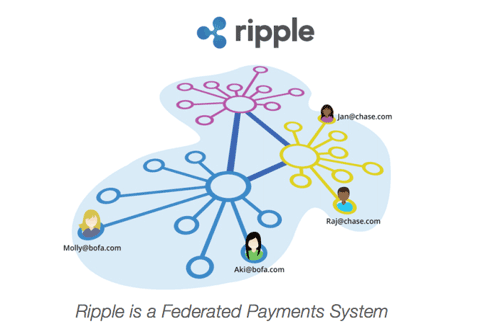
Ripple Gateways
Fiat currency balances traded on Ripple protocol are only redeemable at specific "gateway" from which the digital money is issued. Gateway is the place where fiat currency enters and exits the Ripple protocol.
Gateway may seem similar to traditional commercial banks in practice, but gateway could be any business that provides access to Ripple protocol including banks, money service businesses, marketplaces, or any other financial institution providing the services of accepting cash deposits, issuing balances into user accounts and accepting users withdrawals on demand.
Popular gateways for the Ripple Protocol include SnapSwap, Bitstamp and Gatehub.
Gateways are of utmost importance for Ripple ecosystem because they allow funds to enter the system and to be redeemed outside of it. Gateways enable currency exchanges and transfers for users by backing the funds that enter the Ripple protocol. Each currency on Ripple has its specific issuing gateway, such as: USDsnapswap, BTCbitstamp, CADBluzelle and so on.
This system is in place to ensure that gateways are only required to back the amount of currency that they approved of issuing, as opposed to the full amount of a given currency type available on the Ripple protocol.
Users need to understand that by exchanging the fiat currency to Ripple through a gateway, they are exposed to counterparty risk.
This holds true for both Ripple as well as the traditional financial system. By holding balances with a specific gateway, the user is at risk of losing the value of its balances if the gateway refuses to honor the balance because a balance is nothing more than a gateway's promise to repay its liability.
Therefore, it is critical for users to only hold balances at creditworthy gateways. Ripple protocol by default assumes that users acknowledge the gateway's counterparty risk when users hold their balances in a specific gateway.
Consensus and Security
The Ripple protocol does not make use of Proof-of-Work or Proof-of-Stake hashing algorithms. Instead it relies on a consensus algorithm to track accounts and the balances associated to each account. The ledger is continuously and automatically updated by the Ripple Transaction Protocol so that an identical ledger exists on thousands of servers around the world and can be viewed by anyone at any time.
Ripple protocol reaches consensus globally within seconds after changes are being made. The consensus process allows for fast, secure and decentralized transaction settlement on the Ripple protocol by omitting troublesome centralized transaction settlement with limited security guarantee.
Ripple As A Network for Transactions
The Ripple Protocol keeps running on a system of PCs/servers over the world much like web servers that serve site pages. The PCs in the system check the exchanges utilizing the calculation determined in the Ripple Protocol. They likewise help coordinate the best costs and play out various different errands that keep the framework running easily.
Outstanding amongst other things about the Ripple Protocol is that the system is immediate and distributed. The immediate shared system disposes of the center man and in this manner all the cost of sending cash electronically.
For instance, if I somehow happened to send cash for an installment to another person by means of Paypal, the individual getting the installment would be charged around 3% for the expense. With Ripple, it's beside nothing.
The motivation behind why I say beside nothing, as opposed to nothing, is on the grounds that a little division (100,000th) of one Ripple unit is utilized for security purposes in every exchange, except the cost is immaterial.
The key point is that Ripple influences any sort of money to trade between clients basically free of any charge.
Ripple As A Currency Exchange
While Bitcoin and Ripple share numerous likenesses, one of the fundamental qualifications is that Ripple is intended for the exchange of various monetary forms (counting Bitcoin), and hypothetically any cash to any money.
For instance, in Ripple you can trade dollars for yen, bitcoin for euros, et cetera. You can do that all inside the Ripple arrange. You could even hypothetically exchange things, for example, visit flier miles for dollars.
On Ripple, you choose what your favored monetary forms are, both for paying and accepting. While executing, the convention consequently finds a pathway for your cash with the goal that the other client gets it in their favored money.
For instance, in case you're sending cash to a relative or companion in another nation, you could send it in dollars and they could get it in euros, with no charges for money trade. The Ripple Protocol does everything rapidly and safely through the wire and matches monetary forms on the fly.
Then again, Bitcoin is composed only for Bitcoin. Any trade of Bitcoin into an alternate cash must be outside of the system.
The way that Bitcoin can be exchanged Ripple to and from different monetary forms makes Ripple and Bitcoin awesome compliments to each other, instead of contenders.
Ripple As A Digital Currency
All together for the Protocol to encourage exchanges between all monetary standards, there must be a mediator money in the framework constantly. In this manner, the Ripple Protocol determines Ripple units (XRP) as the primary unit of cash. It goes about as a mediator between different monetary forms (when required), and assumes a part in security (ex: ensuring against spamming).
- Overview - Table of Contents
- What Is Ripple?
- Getting Started With Ripple
- How To Get A Ripple Wallet?
- Ripple Resources
- How To Buy Ripple?
- Where To Spend Ripple?
- What Is Ripple Mining?
- Latest Ripple News
At the purpose of Ripple's creation, 100 Billion XRP existed in the framework which as indicated by convention can't increment and along these lines they'll never encounter swelling. The estimation of a XRP will vary in light of the free market, and if essential, the XRP might be fractionalized, to consider more Ripple sum choices, (e.g. 1/10 of a Ripple) and in this way more clients.
Getting Started With Ripple
At this point, you may have officially known about Ripple, the new decentralized cryptographic money venture that has been influencing waves (to quip planned) in the Bitcoin people group. While Bitcoin enables anybody to hold, send and get bitcoins over a decentralized system to and from anyplace on the planet with greatly low expenses, Ripple looks to enable anybody to do an indistinguishable thing with some other cash from well.
Keeping in mind the end goal to begin with Ripple, you will initially need to open a Ripple wallet. Much the same as Bitcoin in 2009, there is right now just a single Ripple customer accessible, the official one at ripple.com, in spite of the fact that it is considerably more capable and significantly simpler to use than BitcoinQt – the customer is a web interface, no product downloads required.
The procedure is as basic as making a record at some other site; basically click "Begin swell" trailed by "Make a record" and go from that point.
When you have a record, the subsequent stage is to initiate it. Not at all like in Bitcoin, you can't just make the same number of Ripple accounts as you need essentially by producing new private keys; you additionally need to make an underlying store of 50 XRP, Ripple's inner cash, all together for the record to wind up plainly usable.
Now, there are two approaches to get this underlying store. In the first place, OpenCoin at times makes free XRP giveaways, giving out liberal amounts of XRP to the greatest number of individuals as it can reach.
For the time being, the organization is focusing on the Bitcoin people group, thus its initially significant giveaway expected clients to post in a discussion string on [Bitcointalk](http://bitcointalk.org), a prevalent Bitcoin gathering.
Later on, giveaways in light of Facebook records and mobile phone numbers are both liable to occur. In the event that you are not sufficiently fortunate to detect a giveaway, or excessively anxious, making it impossible to sit tight for one, you can discover another person to purchase XRP from.
The biggest Ripple people group at this moment are at https://ripple.com/discussion/and http://reddit.com/r/ripplers; in the event that you have BTC to exchange, you can without much of a stretch discover somebody to give XRP in return.
In the event that you need to purchase more XRP later there is additionally a "decentralized trade" within Ripple that enables you to trade some other cash inside the Ripple framework for XRP, however it expects you to as of now have 50 XRP in your record to utilize.
The procedure for sending and accepting in Ripple is the same as with Bitcoin; in the "Get" tab of the Ripple wallet, the interface furnishes you with a Ripple address, which looks precisely like a Bitcoin address except for beginning with a "r" rather than a "1".
To send an installment to somebody, you essentially enter their address, the money and the sum you wish to send in the "Send" tab. The procedure can be utilized to send any money that you have in your Ripple account, in spite of the fact that on the off chance that you and the beneficiary are not connected through a chain of trust the main cash that you will have the capacity to change over is XRP.
Once your record is stacked with no less than 50 XRP, you will probably need to get some cash in different monetary standards (eg. BTC or USD) into your record. So as to do this, you should open a record at a passage.
There are two alternatives for doors up until this point: WeExchange and BitStamp. The procedure with WeExchange fills in as takes after. To start with, join and make a WeExchange account. Login to WeExchange and go to Funds - > Add Funds - > BTC to get a Bitcoin address that you can store your bitcoin to (fiat monetary forms can be kept as well at the same time, of course, Bitcoin is by a wide margin the most effortless).
When WeExchange affirms your store, go to Funds - > Withdraw Funds - > Ripple. At the base of the page, you will see a rundown of addresses you can trust. Open your Ripple wallet and go to the "Propelled" tab. Snap "Trust", and add the BTC deliver to your put stock in list, entering a trust sum in any event as vast as what you are keeping.
This makes a credit line amongst you and WeExchange that enables WeExchange to send you BTC – or, all the more accurately, an IOU for BTC, through the Ripple organize. At that point go to the "Get" tab and duplicate your Ripple address. Back in WeExchange, select "BTC" as the pull back money, enter the store sum and glue in your Ripple address.
Furthermore, there you go, you have BTC in your Ripple account.
So as to change over the BTC into another cash, by and by in Ripple go to the "Propelled" tab and snap "Exchange". At the highest point of the exchange interface, select the "BTC/XRP" choice in the event that it is not chosen as of now, and tap on "change guarantor".
Duplicate in a similar Ripple address that you went into your trust rundown to set WeExchange as the cash guarantor for BTC. At that point, through the exchange interface, offer your BTC for the other cash simply like you would exchange BTC for fiat money at a trade like MtGox or BitStamp.
Unless you chose to influence an offer over the present "offer" to cost trying to secure for yourself a superior arrangement, the exchange should process rapidly and, voila, you have the money of your decision.
Concerning where you can spend your Ripple reserves, so far there is just a single dealer tolerating Ripple for installment: Private Internet Access. Private Internet Access right now just takes XRP – no Ripple USD or BTC exchanges yet, and the XRP installment choice is, for the time being, genuinely costly contrasted with the USD or BTC cost of $39.95 every year since XRP does not yet have a reasonable market cost.
Note that when Private Internet Access gives the deliver to you to send the XRP, the address that it gives incorporates a numerical token toward the end – something like r9EUYx41zx3audeARUwpkDF7VuwcmbwYTU?dt=2399767994. Make a point to incorporate the full address, with the token, when making your installment – the token is incorporated into the Ripple exchange, and discloses to Private Internet Access which arrange the installment is for.
- Overview - Table of Contents
- What Is Ripple?
- Getting Started With Ripple
- How To Get A Ripple Wallet?
- Ripple Resources
- How To Buy Ripple?
- Where To Spend Ripple?
- What Is Ripple Mining?
- Latest Ripple News
How To Get A Ripple Wallet?
Setup Ripple Wallet Using Ledger
If you have a Nano S, first make sure you run 1.3.1 firmware. To know if you need to update, open the Settings on the Nano S itself, and go to Settings > Device > Firmware. Follow these steps if you need to upgrade. The Blue doesn’t require any specific firmware.
1. install the Ledger Wallet Ripple application on your computer
- Go to this page and click on the "GET THE APP" green button
- Download the Ledger Wallet Ripple application (the application is signed by an "Epic Dream SAS" certificate)
- Open the downloaded folder to install it:
- - On Mac, you must run a 10.8+ OS
- - On Linux, don't forget to set up the updev rules
- - On Windows, you must run at least Win7: click on "Additional Information" to launch the installation despite the anti-virus warning (it won't affect the integrity of your PC)
2. install the Ripple application on your device via the Ledger Manager
- Launch the Ledger Manager (click to see how to install and use it if you don't have it installed yet)
- Connect your Nano S or your Blue, enter your PIN, and stay on the dashboard.
- Click on the green bottom arrow icon near the Ripple logo
- Confirm the installation when required on your device.
- Quit the Ledger Manager
These 2 first steps are only required once. Now everything is ready to manage your Ripple account.
3. Once these apps are installed, to open your Ripple account, just:
- Open your Ripple application on the device itself
- Disable the "Browser support" setting of this Ripple app
- Ripple > Settings > Browser support
- ON A NANO S
- - scroll with the right button to find the "settings", press both buttons to open them
- - scroll with the right button to find the "browser support", press both buttons to open it
- - select NO by pressing both buttons to disable the browser support
- ON A BLUE
- - tap on the top left menu
- - disable the "browser support" by taping on it to make the slider displayed in grey
- Close all other wallets or manager on your computer
- Launch the Ledger Wallet Ripple on your computer (not from Chrome)
- The wallet synchronizes and opens
A Ripple Wallet is basically the same as your physical wallet, except that it is digital. This is how you setup a Ripple Wallet using RippleClient:
STEP 1. Secure Your Computer
If you're planning on making any transactions using Ripple, you need to make sure your computer is secure. If your computer is not secure (for example, if it has malware on it), then your Ripple Wallet is not secure either.
Here are two useful tools that you can use to check for malware:
- Windows: Malwarebytes
- Mac: ClamXav
STEP 2. Install the Ripple Client
Go to http://download.ripple.com/ and download RippleClient for your computer's operating system.
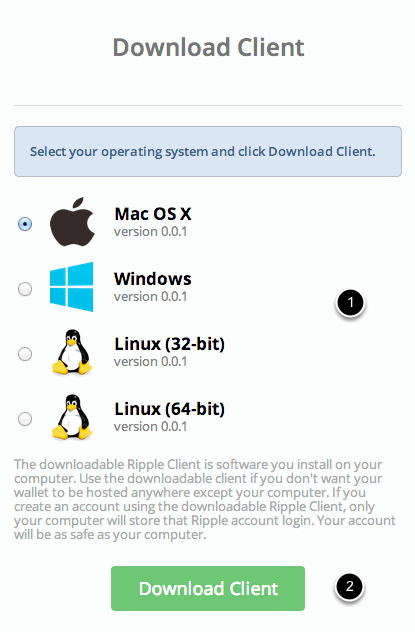
Once downloaded, double click on the installation package and go through the install procedure.
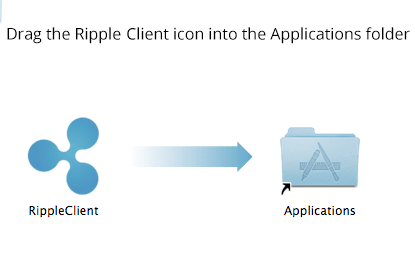
Launch RippleClient using the shortcut that was created for it or by using the search feature in your operating system.
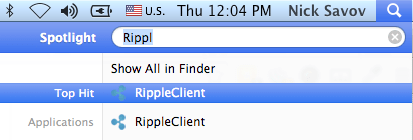
STEP 3. Create a Wallet
When you're first getting started, you'll want to create an empty account (i.e. create a wallet).
- "Open existing account" is for people who already have accounts with RippleClient.
- "Create a new account with a secret key" is for people who are transferring their Ripple Wallets from the web client (or another client) to the desktop client. We can cover this in our next tutorial.
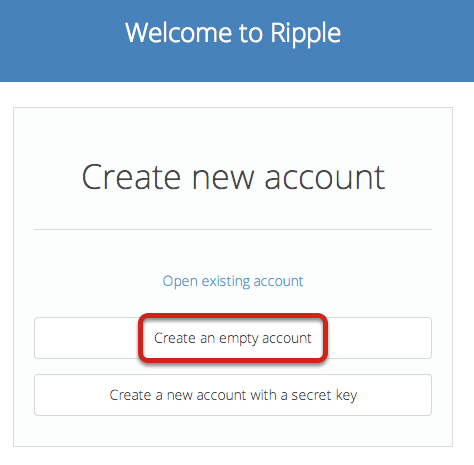
You'll then be presented with a popup to download the wallet. Be sure to change the name and location to something that you'll remember and be able to find later.
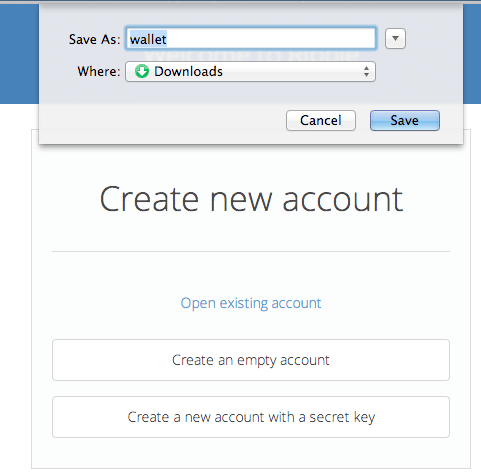
Create a strong password with letters (including capitals), numbers, and symbols that you'll be able to remember or that you'll write down and store for safe keeping.
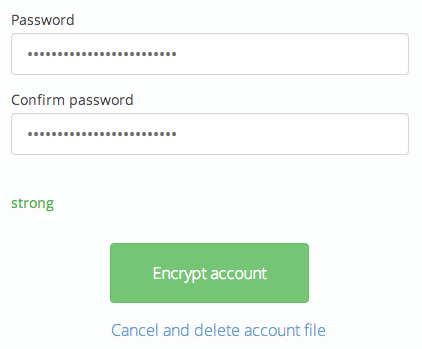
Congratulations! You've just created your Ripple Wallet!
You're now presented with your information. Everything should be kept secret from others, except for your Ripple Address.
Your passphrase is your password to access your account.
Your Ripple Address is what you can share with others. It's what they'll use to send you funds. It's similar to your bank routing number and your email address.
Finally, there's your secret key. With it, anyone can access your money, so be sure to keep it safe. Store it in a safe location that only you know about and have access to.
Once that's done, click on "Yes, I saved my secret key" to continue.
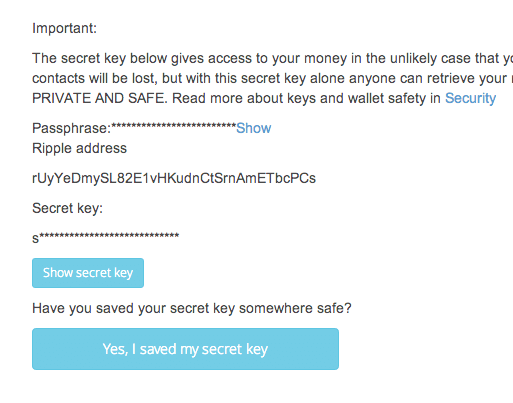
STEP 4. Fund Your Wallet

Now that you have a wallet, it's time to get some funds into it.
Other Options To Create Ripple Wallet
- Atomic Wallet - is a fully decentralized, non-custodial multicurrency wallet, supporting Ripple and 300+ coins and tokens. Atomic provides an interface that allows you to not only manage, but also exchange and buy cryptocurrencies without using external services.
- GateHub Wallet - the simplest way to create a Ripple wallet
- Rippex - which is a downloadable desktop cinet
- (The World Exchange.net) - which allows you to create a cold wallet online
- http://www.ripply.eu which allows you to create a paper wallet online. You can also get it from their github: ripply-eu/ripply-paper-wallet
- Then there’s the minimalist client which can be downloaded from github as well: jatchili/minimalist-ripple-client
Ripple Resources
TUTORIALS
- Gateway Guide
- Listing XRP as an Exchange
- How to Multi-Sign
- Issuing and Operational Addresses
- RippleAPI Beginners Guide
- Payment Channels
- rippled Setup
- Transaction Submission
- XRP Escrow Tutorials </ul>
- Overview - Table of Contents
- What Is Ripple?
- Getting Started With Ripple
- How To Get A Ripple Wallet?
- Ripple Resources
- How To Buy Ripple?
- Where To Spend Ripple?
- What Is Ripple Mining?
- Latest Ripple News
- Overview - Table of Contents
- What Is Ripple?
- Getting Started With Ripple
- How To Get A Ripple Wallet?
- Ripple Resources
- How To Buy Ripple?
- Where To Spend Ripple?
- What Is Ripple Mining?
- Latest Ripple News
REFERENCES
ONLINE TOOLS
How To Buy Ripple?
Atomic Wallet
Atomic Wallet is a popular multicurrency wallet supporting over 300 coins and tokens. The wallet allows you to buy Bitcoin, Ethereum, XRP (Ripple), Litecoin and Bitcoin Cash right in one interface. It’s remarkable that the wallet provides all-in-one solution for every cryptocurrency holder. Atomic Wallet is non-custodial which means that all users’ private keys are encrypted on their devices and can be used anytime. The keys are well-protected with a 12-word seed phrase. Atomic Wallet has built-in services allowing you to exchange and buy Bitcoin and other cryptos with a credit card in one interface. The wallet also features the option to use Atomic Swaps, the on-chain technology, for swapping for Bitcoin, Litecoin and QTUM.
How to BUY RIPPLE?1. Install Atomic Wallet
Credit and Debit card accepted with estimated fees = 2%.
2. Get Verified
To Purchase XRP you need to pass the verification process to prevent fraud and to prove that it's really you.
3. Buy XRP
XRP will be sent to your account within 24 hours. In the most cases it takse less than an hour.
Bitstamp
HOW TO BUY XRP ON BITSTAMP (XRP/EUR, XRP/USD, XRP/BTC TRADING PAIRS)
To purchase XRP you will first need to open and verify your Bitstamp account. When the account verification is successfully completed, you will be able to deposit funds and purchase XRP.
OPEN BITSTAMP ACCOUNT1. To open a Bitstamp account visit: https://www.bitstamp.net/account/register/
2. Enter your information. An email with username and password will be sent to your registered email address.
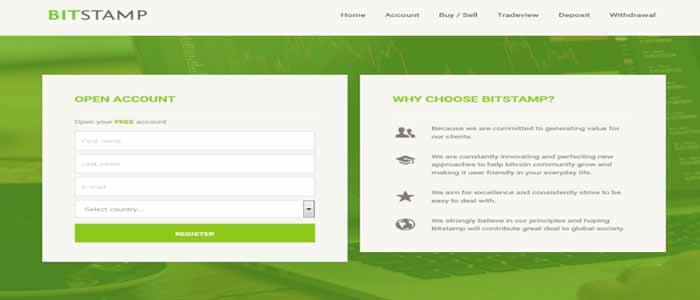
3. Use the provided user name and password to login to your newly created Bitstamp account: https://www.bitstamp.net/account/login/
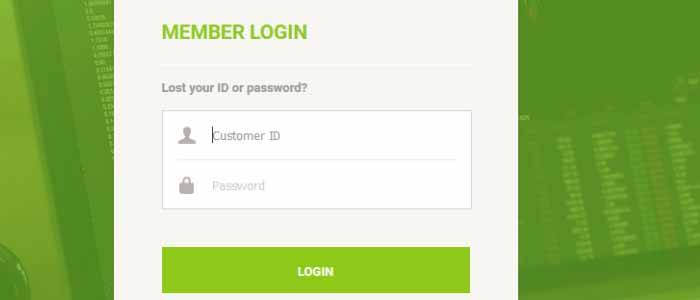
4. Change the password as prompted upon login.
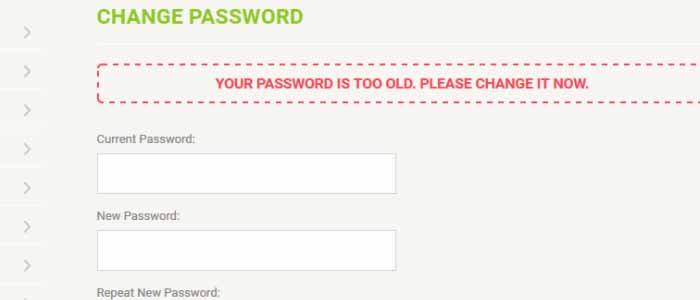
5. For additional security, enabling two-factor authentication is recommended: https://www.bitstamp.net/account/security/two-factor-authentication/
VERIFY BITSTAMP ACCOUNT
1. To submit a verification request visit: https://www.bitstamp.net/account/verify/
2. Enter the required information and upload your documents. Click SUBMIT VERIFICATION REQUEST to proceed.
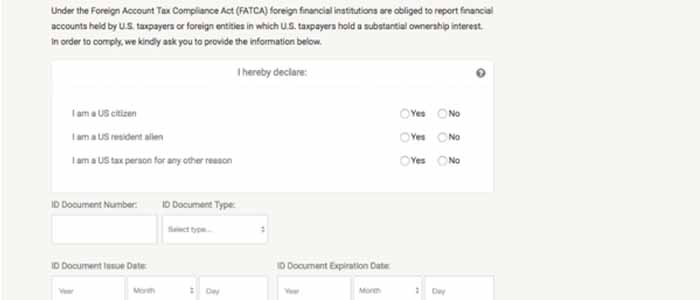
3. Verification request is now submitted. Bitstamp will review it and send the results to your registered email address.
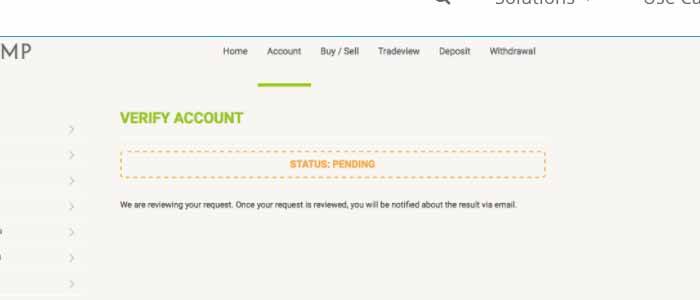
4. If you require further assistance with account verification, please open a support ticket here: https://www.bitstamp.net/support/
5. Once successfully verified, you will be able to deposit funds and purchase XRP.
DEPOSIT
1. To deposit funds visit: https://www.bitstamp.net/account/deposit/
2. Select the preferred bank transfer method in the left-side menu (SEPA or International wire).

3. Fill out the required information and press DEPOSIT to proceed.
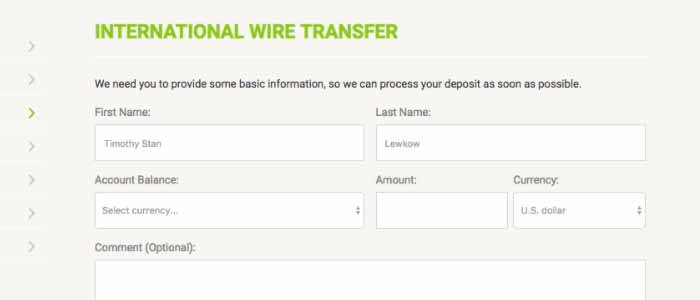
4. On the next page, Bitstamp’s banking details will be provided. To deposit funds to your Bitstamp account, please send the transfer to the provided bank account from a bank account held in your name.
5. When the funds are credited to your Bitstamp balance, you will receive a notification to your registered email address. You can check your account balance here: https://www.bitstamp.net/account/balance/
6. Now you are ready to purchase XRP.
BUY XRP
1. First you will need to select the correct market (XRP/USD, XRP/EUR, XRP/BTC), depending on which currency you wish to use to purchase XRP.
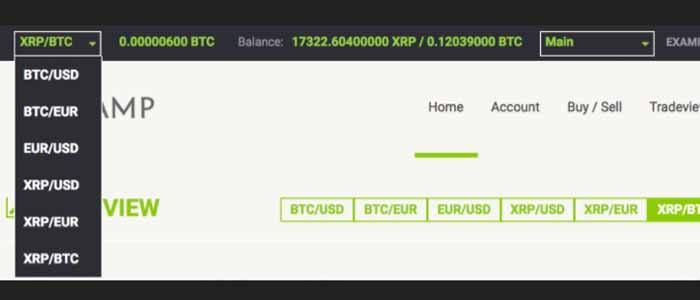
2. Visit the »Buy/Sell« section: https://www.bitstamp.net/market/order/instant/
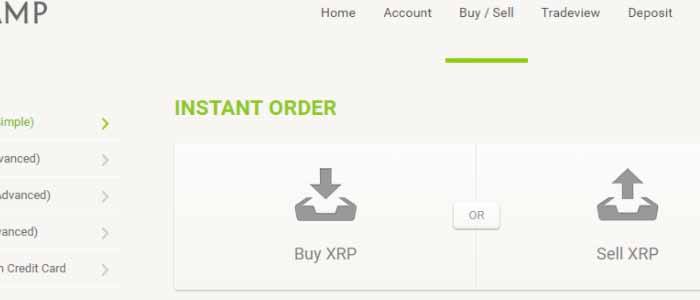
3. Choose »BUY XRP«. Enter the amount you wish to spend into the »I want to spend« window. Click Buy XRP to confirm.

4. XRP will be bought and added to your XRP balance. You can check your account balance here: https://www.bitstamp.net/account/balance/
5. For advanced trading options check visit Tradeview (https://www.bitstamp.net/market/tradeview/) and read the FAQ (https://www.bitstamp.net/faq/)
Kraken
1. Go to https://www.kraken.com/signup and create an account. After you enter your information and click Sign Up, Kraken sends you an email to verify your account.
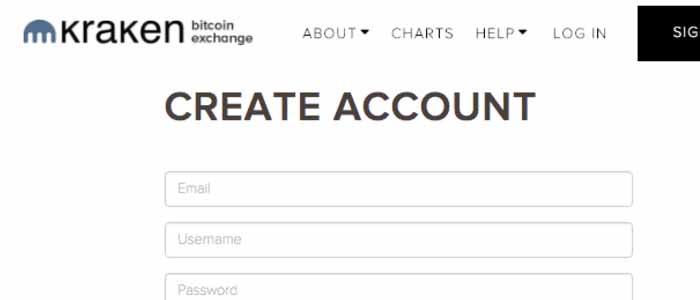
2. Activate your Kraken account by clicking the link in the email or copying and pasting the activation key in Kraken’s account activation page.
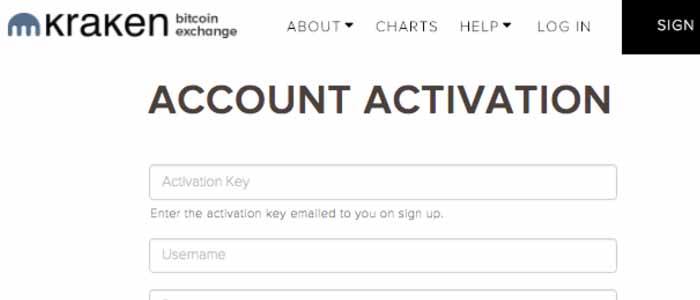
3. Verify your account by going to Account > Get Verified on the Kraken website. To make bank deposits required to buy XRP, Kraken requires Tier 2 customer verification. This means providing customer identification information, such as your name, phone number, and address. (Note: In some jurisdictions, Tier 3 verification is required to make bank deposits. Tier 3 verification requires uploading a valid government-issued photo ID and proof of residence documentation.)
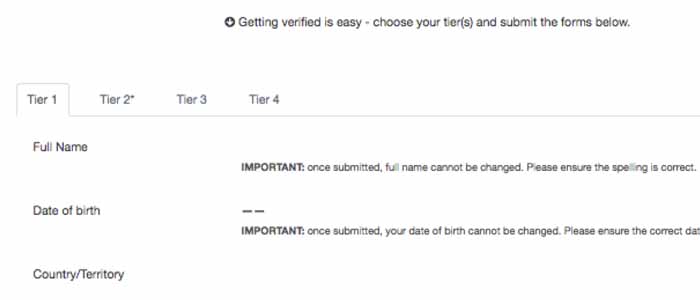
4. After you verify your account, deposit funds to your Kraken account by going to Account > Funding > Deposit and selecting the type of deposit. For more information about making deposits, see the Kraken Support Center.
a. Place an order to buy XRP by going to Account > Trade > New Order
b. Select the currency pair with the fiat currency that matches the currency of your deposit. Make sure you select the correct currency pair. The currency pair you select determines which currencies are bought and sold. For example, if you select XRP/USD, clicking Buy means that you buy XRP and sell USD. With the same currency pair, clicking Sell means that you sell XRP and buy USD. For more information about trading on Kraken, see Trading Basics available in the Kraken Support Center.
c. In the New Order tab, select the Simple interface and place a Buy order for XRP.
d. Enter the amount of XRP that you want to buy. You can choose to buy at the current market rate or place a limit order.
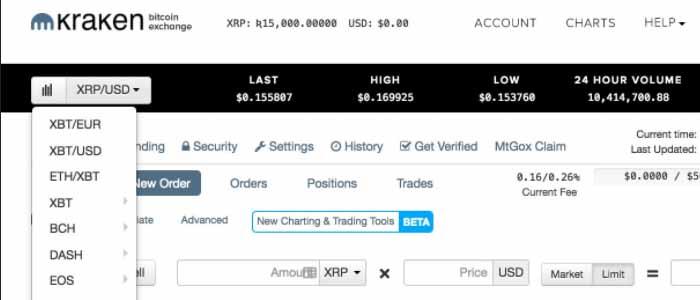
5. To buy XRP with your USD:
a. Select the XRP/USD from the currency pair drop-down menu.
b. In the New Order tab, select the Simple interface and place a Buy order for XRP.
c. Enter the amount of XRP you want to buy and submit your order.
BTCIndia
HOW TO BUY XRP ON BTCXINDIA (XRP/INR TRADING PAIRS)
You can buy XRP on BTCXIndia using INR. You will need to sign-up for an account. After successful verification of your account, you can deposit INR and buy XRP.
SIGNING UP FOR AN ACCOUNT
Signing up for an account will help you buy or sell your XRP.
1. Go to https://btcxindia.com/new-account/
2. Fill up the fields with the required information
An email and SMS will be sent to your email address and mobile number. The email consists of a verification link and the SMS contains a verification code.
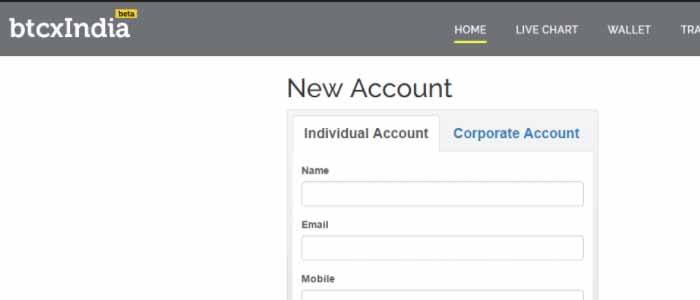
VERIFYING YOUR MOBILE NUMBER
As soon as you register your details, you will be prompted to verify your mobile number here:
1. Enter the verification code received on your mobile number
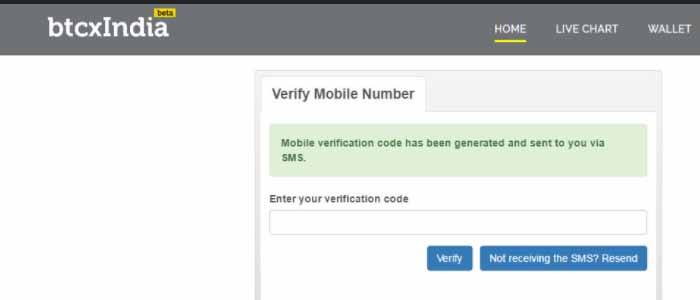
VERIFYING YOUR EMAIL ADDRESS
Click the link provided in the verification email. Once your email ID is verified, an email consisting your Client ID will be sent to your registered email address.
LOGGING IN TO YOUR ACCOUNT1. Go to: https://btcxindia.com/login
2. Enter your registered email address
3. Enter your Client ID
4. Click the Generate Dynamic Access Code
5. Enter the Dynamic Access Code (sent your registered email ID or mobile number)
6. Click Secure Login
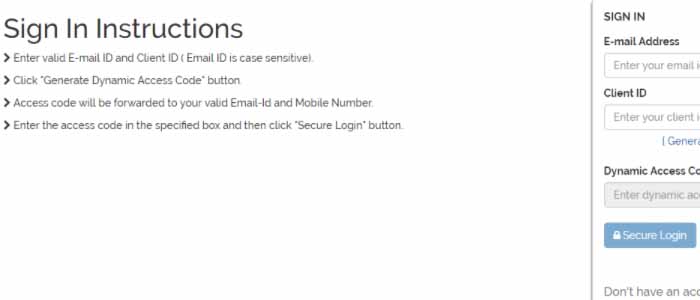
Once you are logged in, you will be taken to the Trade page.
COMPLETING BTCXINDIA’S KYC PROCESSYou need to furnish government authorized ID to be able to use the BTCXIndia website to buy your XRP. Please note that this is a one time process.
1. Go to: https://btcxindia.com/wallet/
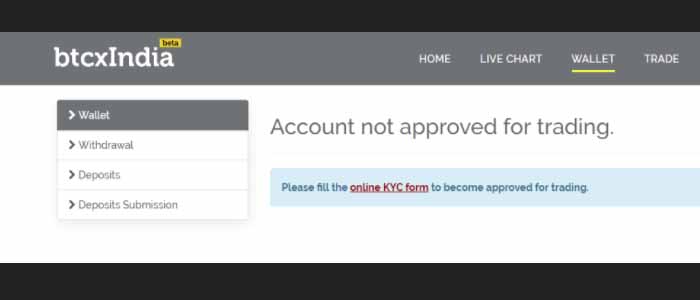
2. Click ‘online KYC form’ available on the top of the page
You will be taken to the KYC page. You will need to enter the required information in all the forms. The forms are: Identity Details, Address Details, Bank Account Details and Other Details. This is a mandatory process.
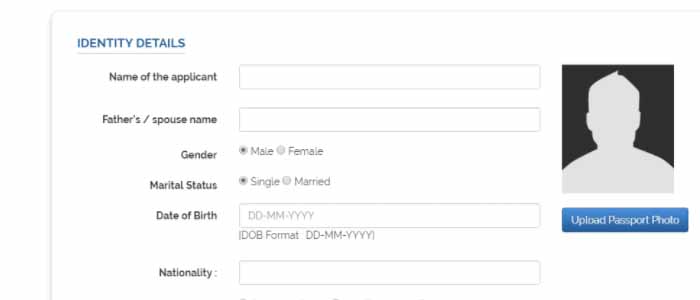
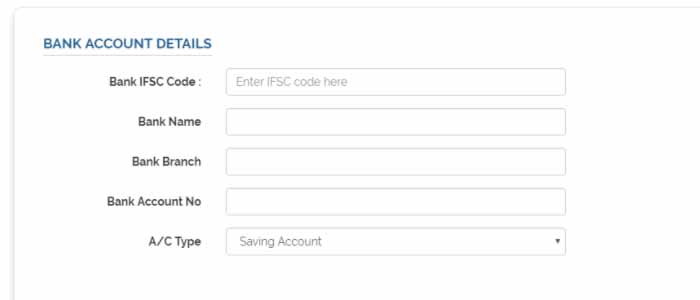
3. Click Submit in the Declaration page
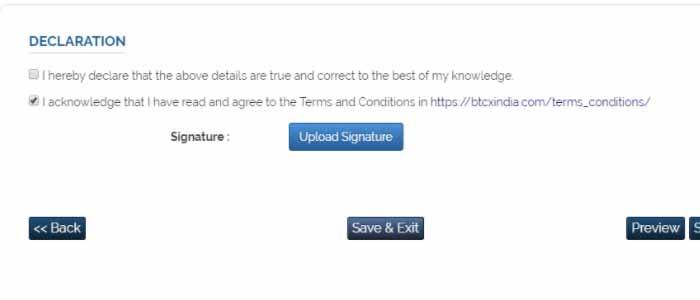
Your KYC will be verified and upon successful verification, your account will be activated. The KYC verification takes certain duration.
DEPOSITING INR
You will need to deposit INR into our bank account respectively before you can buy XRP.
1. Go to https://btcxindia.com/wallet
2. Click the Deposits tab
3. You can use the BTCXIndia bank account details.
4. Transfer your INR to the BTCXIndia bank account
5. Click the Deposits Submission tab
Fill in the information in the fields.
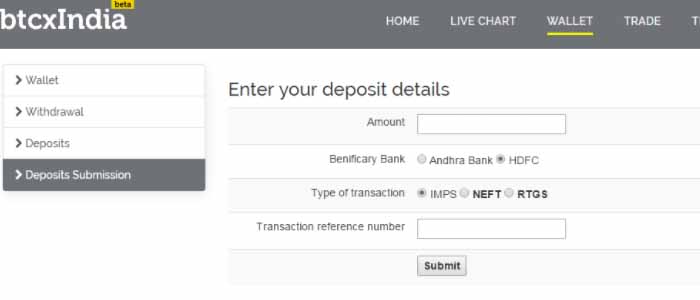
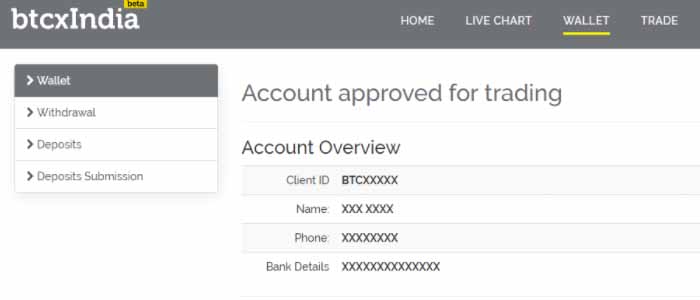
TRADING YOUR XRP
You can buy your XRP by using the Live Order Book available on the Trade page.
1. Go to https://btcxindia.com/trade/
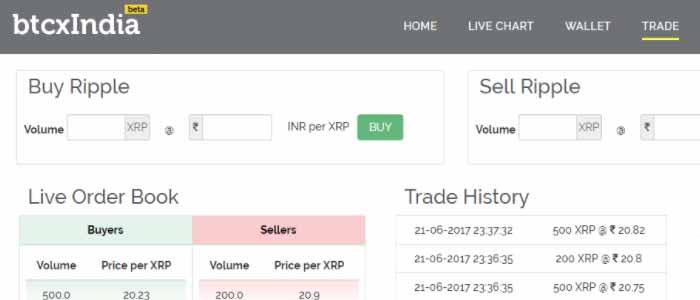
Refer to the Live Order Book for buying and selling rates of XRP available under Buyers and Sellers respectively.
2. Enter the required XRP and INR and click Buy
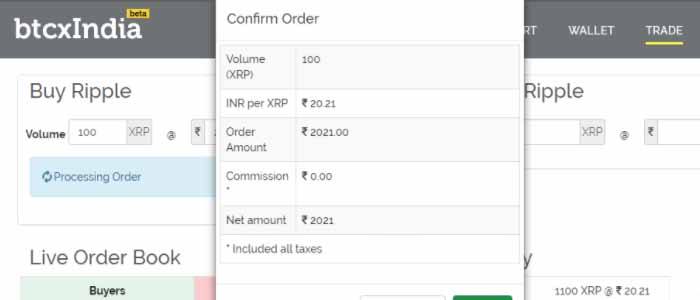
You will be prompted a with a dialog box to confirm or cancel your order.
3. Click Confirm to buy or Cancel Order to cancel.
4. The bought XRP will be transferred to your wallet.
Other Exchanges You Can Buy Ripple
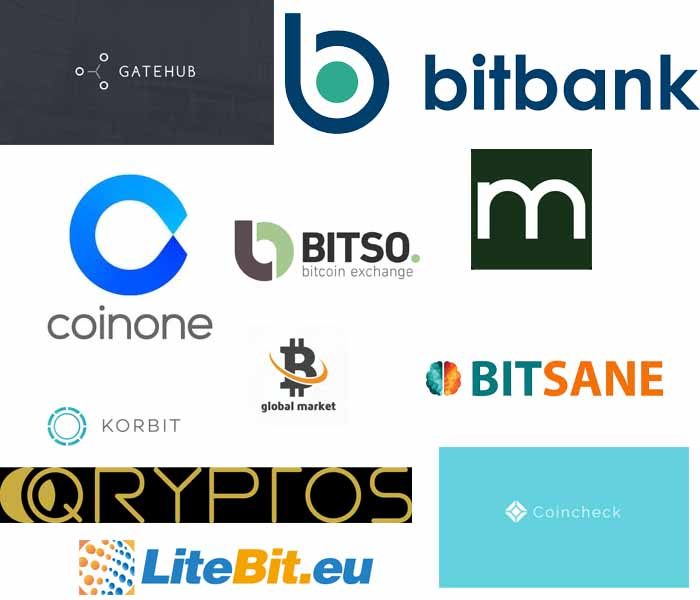
Where To Spend Ripple?
XRP has a dual function
1) As a bridge currency (For example, if you want to convert USD to X and there are no online exchanges which support this, technically you can convert USD To XRP and XRP to X)
2) As a transaction fee mechanism (although the amounts are negligible)
What Is Ripple Mining?
Would you be able to specifically mine Ripple? The appropriate response is No. You can't mine Ripple straightforwardly as this coin can't be mined and the main individuals that can produce Ripple would be the organization that has made it.
There are just 100 Billion Ripples made on its discharge and every exchange would wipe out the Ripple utilized. What's more, once a Ripple is utilized this can't be utilized for your next exchange.
This likewise implies the more individuals utilizing Ripple or the more exchanges utilized through the Ripple framework would gradually kill its own coins and obviously raise its esteem.
So how would you mine Ripple? Since you can't mine Ripple straightforwardly, you have to investigate sites that can mine Bitcoin and change over your Bitcoin to XRP. Along these lines, you can get your hands straightforwardly on Ripple without paying for it specifically.
Many people are really purchasing XRP today because of the idea of its framework and in the long run the rising value it would soon be getting.
Latest Ripple News
SBI Ripple Asia has today consented to an association arrangement with DAYLI Intelligence, an auxiliary of DAYLI Financial Group, to bring Ripple's venture blockchain answers for cross-outskirt installments toward the South Korean market.
